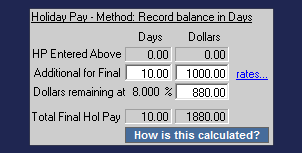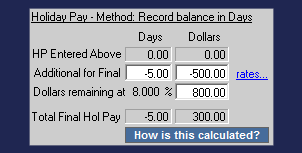Final Pay Holiday Pay Calculations
See Also (click):
Final Pay Procedure
The procedure for a Final Pay
and related questions
Examples below use holiday pay of 4 weeks per year (5 days per week giving 20 days per year) and 8%. Your figures may differ depending on your employees contract, and whether you are using days or hours for holiday pay.
>> For a final pay, the employee can be included in the normal pay run with the other employees.
>> You will enter allowances (if any) and deductions (if any), and will enter any hours worked during the final pay period.
>> After entering in the normal pay run figures above, you will click the "Final Pay".
For an employee on the "percentage of gross" holiday pay method Payroll Pro will fill in the holiday pay totals automatically for you with the employees remaining balance, so no information about calculations is really required here. The remainder of this page explains the calculations for employees who are paid holiday pay using the days (or hours) method of holiday pay.
For employees on the days (or hours) method of holiday pay, clicking "Final Pay" will automatically fill in the holiday pay boxes with the remaining balance. Payroll Pro will verify the value of the days with you in the same way it does when an employee takes holiday pay. As per the Holidays Act it will also pay the employee 8% of the gross earned since the employees last anniversary date.
The Holidays Act says the employee is paid out all their remaining balance in days, at a value which is the greater of their ordinary weekly pay or the average of their past 52 weeks pay (the same as when the employee takes annual leave) (section 24). The employee is also paid 8% of the value of these days (section 26). The employee is also entitled to 8% of the gross pay they have earned since their last holiday pay anniversary (section 25).
(See Holidays Act section 24, section 25 and section 26. If you click these links, click your browser's "Back" button afterwards to return to this page)
Example 1
Balance remaining is 10 days (the value of these being $1000). The employee has earned $10,000 gross pay since their last anniversary. As per the Holidays Act this $10,000 also includes any holiday pay that was paid since the last anniversary, since holiday pay is counted as gross pay under the Holidays Act.
Note that the dollar amount on which the 8% is calculated is the total since the employees last anniversary date, and not the financial year - so this total could be (and usually will be) different to the year to date total gross on the payslip.
The employee is therefore paid:
10 days = $1000
plus 8% of the above = $80
plus 8% of gross ($10,000) = $800
TOTAL final holiday pay is $1880.
On the TimeSheet window, you will see the box to the lower left:
(the two 8% figures are combined to show one total of $880)

Example 2
Balance remaining is negative 5 days - the employee took 5 days in advance, and was paid $500 total for these. The employee has earned $10,000 gross pay since their last anniversary (this excludes the holiday pay that was paid in advance, since this is being paid back).
The employee is therefore paid:
-5 days = -$500 (they pay back $500)
plus 8% of gross ($10,000) = $800
TOTAL final holiday pay is $300.
On the TimeSheet window, you will see the box to the lower left:

So you can see that the 8% in this case is larger than the amount being paid back, so the dollar amount is still a positive number.
If the total final holiday pay was a negative amount, then as long as the current normal hours worked came to a figure greater than this, then the gross pay will still be a positive number and so the employee can be paid.
For Example:
Total Final Hol Pay -10 days, -$200
15 hours worked in the final period giving 15hrs * $20 = $300.
Gross Pay therefore $300 - $200 giving $100 a positive number.
HOWEVER, if the gross pay was a negative amount you will not be able to pay your employee since a pay cannot be negative. If this happens to you it means that you have paid the employee too much in advance, and you may need to discuss this with the Labour Department (now called "Ministry of Business, Innovation and Employment" or MBIE) to see whether you can actually get this back.
